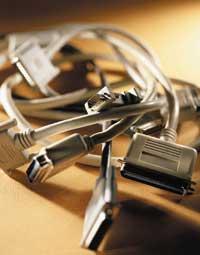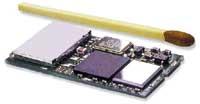Bluetooth: wireless communication
It is undeniable that cables, in most cases, only bother you. For example, when the printer gets damaged, the risk of leaving the computer without the Internet, no voice or image before guessing what the corresponding cable is almost inevitable. In these cases, surely more than one has ever thought: If there were no wires! And this is what new technologies offer.

These technologies include Bluetooth technology, infrared technology promoted by IrDA (Infrared Data Association) and HomeRF (Home Radio Frequency). All of them are specifications designed to allow wireless communication. These specifications describe how to make connections between tools. In this way, we can connect without cables the mobile phone, the computer, the television, the video, etc.
However, as many incompatible technologies and standards have emerged, the problem of cables persists. Each technology needs a receiver and a special transmitter, each connected to the mains. In the end we find the same problem. Bluetooth is a universal tool for connecting all types of peripherals. That is why this technology is gaining the most strength in the computer and telecommunications industry.
How does it work?
Each Bluetooth device has a microchip capable of transmitting and receiving information. It uses an ISM frequency band ( Industrial Scientific Medical) of 2.4 GHz. The use of this frequency band does not require license and is possible in almost everyone. However, in Spain it is not possible to use this frequency band, which can lead to compatibility problems with products manufactured or sold in Spain and outside Spain. Microchips are very small and require very little energy (97% less than mobile phones).
For information exchange, 7 data channels and 3 voice channels can be used at 64 kbit/s. Each device has a single 48-bit sense based on the IEEE 802.11 standard of wireless local area networks (LANs), whereby the device can temporarily be part of a piconet.
Piconet is a network of connected devices. In total, two to eight devices can be connected. One of them will be ‘the boss’ and the rest ‘the assistants’. In the same coverage area there can be 10 piconets. In addition, a device from one piconet can be connected to another device from another piconet. In this case the scatternet is completed (connection between several unsynchronized free piconets).
Connections between tools are made by pairs. For this, the distance between devices can be up to 10 meters, while with the amplifiers can reach up to 100 meters, but in this case a distortion can occur.

In version v1.0 of the year 1999, the data exchange rate may vary between 1 Mbit/s and in version v2.0 it is expected to reach a speed of 2 Mbit/s. In addition, both versions will be supported. Random frequency jumps are also used to prevent interference. It has encryption and authorization mechanisms to control the connection and ensure data security. Each link is encoded and has interference protection and link loss. Therefore, it can be considered a safe network of short range and without cables.
However, care must be taken with other devices using the same frequency band. On aircraft, for example, the use of the mobile phone is prohibited, and the same happens with devices with Bluetooth chip that can interfere with other elements of the plane.
This technology can have multiple applications, especially in the automotive industry, medicine, appliances and, in general, in normal everyday life. For example, we can have updated computer and mobile phone agendas, we can use mobile phone to open doors and connect home power tools, etc. The time has come to control our environment without getting off the couch!
TrademarkBluetooth is a registered trademark so it cannot be written otherwise or translated into another language. The origin of the name is quite curious. In the 10th century, King Harol Blåtand lived in Denmark (blá: blue, tand: tooth). This king managed to group in a single kingdom several small Scandinavian countries with different regulations. That is why Bluetooth managers decided to give the same name to this new technology. In fact, two companies from two Scandinavian countries are united in one project: Ericsson, from Sweden, and Nokia, from Finland. The project is managed by the SIG (Special Interest Group) group, consisting of Ericsson, Nokia, Intel, IBM, Toshiba, Motorola and 3Com (Palm). In addition, more than 1,600 companies have joined the project and all have the right to use the v1.0 specification, the first version of the Bluetooth specification. |
Buletina
Bidali zure helbide elektronikoa eta jaso asteroko buletina zure sarrera-ontzian











